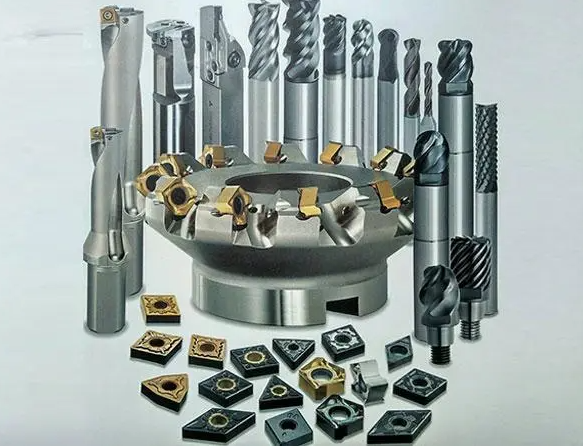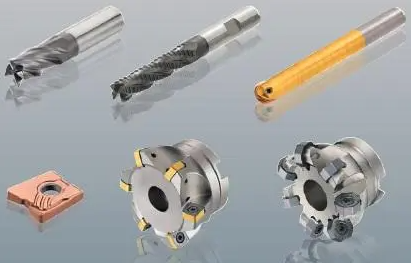
A milling cutter is used for milling processing and has one or more teeth. A cutting tool commonly used for milling operations on milling machines or CNC machining centers. The milling cutter intermittently cuts off the excess of the work piece from each tooth through the movement inside the machine. The milling cutter has multiple cutting edges that can rotate at very high speeds, quickly cutting metal. Different processing machines can also accommodate single or multiple cutting tools simultaneously
Milling cutters come in various shapes and sizes, and can also be coated with coatings, so let's take a look at which milling cutters are used on the machine and what each milling cutter is used for.

Cylindrical milling cutter
The teeth of the cylindrical milling cutter are distributed on the circumference of the milling cutter, and the cylindrical milling cutter is used to process flat surfaces on a bedroom milling machine. Divided into straight teeth and spiral teeth according to tooth shape, and into coarse teeth and fine teeth according to tooth number. Spiral and coarse tooth milling cutters have fewer teeth, high tooth strength, and large chip capacity, making them suitable for rough machining. Fine tooth milling cutters are suitable for precision machining.
End mill cutter
End mill is the most commonly used type of milling cutter on CNC machine tools. The cylindrical surface and end face of the end mill have cutting edges, which can be cut simultaneously or separately. End mills are commonly used to refer to flat bottomed milling cutters, but also include ball end milling cutters and inner second milling cutters. End mills are usually made of high-speed steel or hard alloy and have one or more teeth. End mills are mainly used for small milling operations, such as groove milling, step surface milling, precision hole and contour milling operations
Face milling cutter
Face milling cutters are mainly used for machining flat surfaces. The cutting edge of the face milling cutter is always located on its side and must always cut into the horizontal direction at the set depth. The end face and outer edge of the face milling cutter perpendicular to the tool holder both have cutting edges, and the cutting edge of the end face plays the same role as a scraper. Due to the fact that cutting teeth are usually replaceable hard alloy blades, the service life of the tool can be extended.
Coarse skin milling cutter
Coarse skin milling cutter is also a type of end milling cutter, slightly different in that it has serrated teeth, which can quickly remove excess from the workpiece. The rough milling cutter has a cutting edge with corrugated teeth, which generates many small chips during the cutting process. Cutting tools have good unloading ability, good discharge performance, large discharge capacity, and high processing efficiency.
Ball end milling cutter
Ball end milling cutters also belong to end mills, with cutting edges similar to ball heads. The tool uses a special spherical shape, which helps to extend the tool's service life and improve cutting speed and feed rate. Ball end milling cutters are suitable for milling various curved arc grooves.
Side milling cutter
Side milling cutters and face milling cutters are designed with cutting teeth on their sides and circumference, and they are made according to different diameters and widths. In terms of application processing, because there are cutting teeth on the circumference, the function of the side milling cutter is very similar to that of the end milling cutter. But with the advancement of other technologies, side milling cutters have gradually become obsolete in the market.
Gear milling cutter
Gear milling cutter is a special tool used for milling involute gears. Gear milling cutters act on high-speed steel and are the main auxiliary tools for machining large modulus gears. According to their different shapes, they are divided into two types: disc gear milling cutters and finger gear milling cutters.
Hollow milling cutter
The shape of a hollow milling cutter is like a pipe, with a thick inner wall and cutting edges on that surface. Originally used for turrets and screw machines. As an alternative method of using box tools for turning or for milling or drilling machines to complete cylindrical machining. Hollow milling cutters can be used on modern CNC machine equipment.
Trapezoidal milling cutter
A trapezoidal milling cutter is a special shaped end with teeth set around and on both sides of the tool. It is used to cut the trapezoidal grooves of the work piece using a drilling and milling machine, and to process the side grooves.
Thread milling cutter
A thread milling cutter is a tool used to process threads, which has a similar appearance to a tap and uses a cutting edge with the same tooth shape as the thread being processed. The tool moves one revolution on the horizontal plane and one lead in a straight line on the vertical plane. Repeating this machining process completes the machining of the thread. Compared with traditional thread processing methods, thread milling has great advantages in terms of machining accuracy and efficiency.
Concave semi-circular milling cutters
Concave semi-circular milling cutters can be divided into two types: concave semi-circular milling cutters and convex semi-circular milling cutters. A concave semi-circular milling cutter bends outward on the circumferential surface to form a semi-circular contour, while a convex semi-circular milling cutter bends inward on the circumferential surface to form a semi-circular contour.
The general principle of tool selection is easy installation and adjustment, good rigidity, high durability and accuracy. Try to choose shorter tool holders to improve the rigidity of tool processing while meeting processing requirements. Choosing the appropriate cutting tool can bring twice the result with half the effort, effectively reducing cutting time, improving machining efficiency, and reducing machining costs.
POST TIME: 2024-02-25













